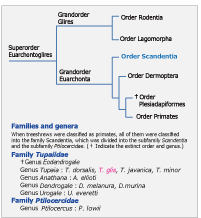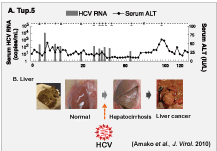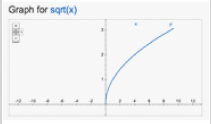|
■Bioresources information is available at the following URLs
|
 |
|
Research and Bioresources <No.25> Treeshrews as New Animal Models for Viral Infections
Kyoko KOHARA (Professor, Transboundary Animal Diseases Research Center, Joint Faculty of Veterinary Medicine, Kagoshima University)
Takahiro SANADA • Daisuke YAMANE (Researcher, Viral Infections Diseases Project, Tokyo Metropolitan Institute of Medical Science)
Michihiro KOHARA (Project Leader, Viral Infections Diseases Project, Tokyo Metropolitan Institute of Medical Science)
|
A treeshrew is a small mammal, which is similar to a squirrel in appearance (Fig. 1). Although treeshrews have been classified as primates in the past, they are now classified as Scandentia (Fig. 2). Treeshrews are indigenous to Southeast Asia, including Thailand, Malaysia, Java, Sumatra, and the southern part of China (Fig. 3).
Treeshrews were first referenced by William Eliot, who was a well-known ship's doctor and part of Captain Cook's crew (1780). Since then, treeshrews have been analyzed in comparative biology and anatomy, and this analysis resulted in many reports.
It has been revealed that treeshrews are susceptible to hepatitis C virus (HCV) and hepatitis B virus (HBV), which were thought to only infect chimpanzees. Since then, treeshrews have attracted the attention of many researchers, and they have been studied in lieu of chimpanzees.
Treeshrews are diurnal, easy-to-breed animals. Their lifespans are 7-8 years, their gestation period is approximately 40 days, and their litters can include 3-5 offspring (Fig. 1). In natural conditions, the breastfeeding of treeshrews occurs once every 48 hours, their eyes open 3-4 weeks after birth, and they are weaned and independent of their parents within 2 months of birth. Treeshrews give birth around 4 times a year, and the number of offspring is approximately 100.
Treeshrews are considered useful as experimental animals because of their high fertility rates. However, the nursing rate of treeshrews is approximately 38%, which is lower than that of mice and rats. By inhibiting cannibalism and child neglect (the causes of the low nursing rate), treeshrews are expected to become more useful than ever. If cloning and genetic modification can be applied to treeshrews, they will be even more likely to be used in experiments. |

Fig. 1. Maturation process of individual treeshrews |
|

Fig. 2. Classification of the treeshrew |
Treeshrews as an experimental animal for infection |
Of the treeshrew species, we have been performing HCV infection experiments by using Tupaia belangeri. We found and reported the following: Within 3 years of HCV infection, liver cancer develops from chronic hepatitis or hepatocirrhosis (Amako et al., J. Virol. 2010) (Fig. 4). There was also a report that treeshrews were susceptible to HBV.
In addition, we found the following: When the hepatocytes of treeshrews were actually transplanted into an immune-deficient mouse to produce a chimera mouse with the liver of a treeshrew, HBV could infect the chimera mouse−and replicate in it (Sanada et al., BBRC, 2016). CD81, SR-B1, CLDN1, and OCLN molecules (that were the receptors for HCV infection) and NTCP molecules (that were the receptors of HBV infection) were derived from treeshrews, so the infection could be transferred to the recipients (Tong et al., J. Virol., 2011; Yan et al., eLife, 2012).
Moreover, treeshrews were reported as being susceptible to hepatitis E (Yu et al., BMC Infect. Dis. 2016). Thus, treeshrews also have the distinct possibility of being experimental animals as models for human infections. However, the major obstacle was lack of analytical tools, such as antibodies and cDNA. We then performed analyses of whole genomes and exhaustive RNA sequencing of treeshrews by using a next-generation sequencer−which produced more than 130 types of antibodies and cDNA clones.
Using these tools, we have established a system of analysis for innate immunity and adaptive immunity responses, and we have been developing an animal model for viral infections−through which the pathogenicity of a virus can be easily analyzed.
|

Fig. 3. Habitat distribution of the treeshrew species |
|

Fig. 4. Pathological changes after the infection of hepatitis C virus
|
Characteristics of treeshrews and their potential as experimental animals |
Treeshrews have various characteristics that make them useful for research. As ecological characteristics, treeshrews are diurnal, their type of sociality is linear (which is observed in many monkey species), their wild individuals squabble over turf, and conflicts are often observed between the same gender. It has been reported that the auditory sense of treeshrews can recognize five sounds, the visual sense can discriminate nine shapes and colors, and they have excellent learning capabilities regarding these senses.
In the morphology of treeshrews, the muscle structures of the limbs and endotheliochorial multi-placentas are similar to animals in the order Insectivora. The following are common in primates: thumb opposability, bones forming the orbital wall, the morphology of incisors, the morphology of the lung and bronchus, and the relationship between the rhinencephalon and visual field. Therefore, treeshrews are difficult to classify.
It was reported that when two male treeshrews were put into one cage, the weaker individual developed depression. Treeshrews can be used as models for depression caused by low-temperature stress, and they can be used to analyze the efficacy of antidepressants (Chi et al., Exp. Animal., 2016). Since treeshrews have an excellent visual sense, they are useful for elucidating the on/off mechanism in the visual cortex (Lee et al., Nature, 2016).
Thus, treeshrews possess certain characteristics of both the orders Insectivora and Primate. Treeshrews also possess unique characteristics (i.e., missing links) that they inherited from primitive mammals. Treeshrews are considered as having great possibilities of valuable experimentation--due to the research on infections and to the characteristics they possess that are similar to humans. We expect that treeshrews can contribute to the advancement of science in the future.
|
|
|
|
|
Search Engine Features |

Google and Yahoo are both search engines that we all use frequently, but did you know that there are many search options you can take advantage of, instead of simply stringing together multiple keywords using the OR operator?
In this article, I will introduce some functionalities of Google Search.

Options for narrowing search results
● Add a [−] (minus sign) in front of a keyword to exclude that keyword from your search results.
Example: jaguar speed −car
● By enclosing a keyword with double quotes[" "], you can search for an exact match of that keyword. Similarly, you can enclose multiple keywords with double quotes to specify the exact order.
Example: "imagine all the people"
● In the above example, if you are unsure of a certain word, you can insert an asterisk [ ∗ ] as a placeholder.
Example: "a ∗ saved is a ∗ earned"
● Numerical values can be searched using the format [minimum .. maximum] to specify a target range. To add a unit to that number, add it as a keyword separated by a space.
Example: camera 1500 .. 2000 pixels
However, you do not need to memorize these search options--you can perform the same searches from the advanced search page (※1).
※1 https://www.google.co.jp/advanced_search
|

Specifying a date range
● If you want to search by the date when a page was indexed or refreshed within Google, you can use the Search Tools (Fig. 1A) and specify the desired date range (Fig. 1).

Searching within a domain
● If you wish to search for a page within a specific website, you can use the syntax [site: domain] to narrow your results down just to that website.
Example: Olympics site:nbc.com
● If the live site cannot be opened due to site maintenance or other reasons, use the syntax [cache: domain] to view information that has previously been cached by Google. Page layout may sometimes be broken in cached pages.
Example: cache:nbc.com

Functionalities other than search
● Calculator
Type an arithmetic expression such as [123*456] and a calculator will be displayed (Fig. 2).
● Unit conversion
Use Google to search for a measurement unit such as [12 yard meter], and the conversion result will be displayed (Fig. 3).
● Drawing a graph
Simple graphs can be drawn by entering a function (Fig. 4).
There are many other features in addition to those introduced above. For example, you can also enter [food calories] to find out the number of calories of a food item; [country time] to find out the current time in a particular country; and [place weather] to display the weekly weather forecast at a location.
| |

Fig. 1. Narrowing the search result using date range

Fig. 2. Example of the calculator

Fig. 3. Example of unit conversion

Fig. 4. Example of drawing graphs
|
Effectively utilizing search engine features can improve your productivity significantly.
I encourage everyone to find out more about the extra features available on your favorite search engine.
(Hiroki Watanabe) | |
|










